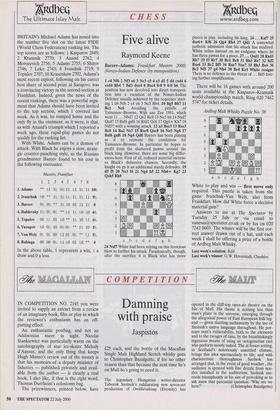COMPETITION
Damning with praise
Jaspistos
IN COMPETITION NO. 2145 you were invited to supply an extract from a review of an imaginary book, film or play in which the reviewer's enthusiasm has an off- putting effect.
An enthusiastic postbag, and not an Addisonian sneer in sight. Nicolai Stankiewicz was particularly warm on the autobiography of star ice-skater Melody d'Amour, and the only thing that keeps Hugh Munro's review out of the money is that his memoirs of a deputy minister of fisheries — published privately and avail- able from the author — is clearly a real book. I also like, if that is the right word, Thomas Durrheim's colostomy bag.
The prizewinners, printed below, have £25 each, and the bottle of the Macallan Single Malt Highland Scotch whisky goes to Christopher Bazalgette, if for no other reason than that because the next time he's on Mull he's going to need it.
The legendary Hungarian writer-director Taborok Szolnok's exhilarating new seven-act production of Orokkevalosag (Eternity) has opened in the cliff-top open-air theatre on the Isle of Mull. His theme is nothing less than man's place in the universe, emerging through the allegorical power of East European folk leg- end — given dazzling authenticity by the use of Szolnok's native language throughout. He por- trays man's vulnerability, both to the elements and to the ravages of time, by the breathtakingly ingenious means of using an octogenarian cast who perform mostly naked. The al fresco setting, in Scotland's notoriously unsettled climate, brings this idea spectacularly to life; and with characteristic thoroughness Szolnok has arranged that, in the event of good weather , the audience is sprayed with fine drizzle from noz- zles installed in the auditorium. Szolnok suc- ceeds triumphantly in his aim of provoking us to ask anew that perennial question: 'Why are we here?' (Christopher Bazalgette)
Philosopher Nick Old's book Life Is Not Worth Living is a masterpiece of concision. The title leaves you in no doubt what you're getting; the text delivers it with the force and speed of an oncoming train. Old's encyclopaedic knowledge of mankind's misdeeds makes for a wonderfully colourful vision of a universe devoid of hope and meaning. His accounts — so well-written one feels he had a ringside seat for most dark episodes in history — grip like an enraged thuggee; but Old's true genius is for persuasion. As he draws you to his pre-ordained conclusion there are bitter pills to swallow, all rendered deliciously sweet by sumptuous prose. Like a toddler to the deep end, I raced towards the dra- matic climax, a call to practical action no one who'd followed Old's arguments could resist. Once picked up, this book is unputdownable. Once put down, this book makes life unlivable.
(Adrian Fry)
A glutton for punishment — or punishment for a glutton? Mary Sholto's new play The Strange Art of Bulimia throws up all kinds of brilliant insights into the private world of eating disorders. In this fabulous, lyrical duologue, we watch two wretched sisters retch their hearts out in search of an impossible perfection. The set is dominated
by an outsize refrigerator and an outsize bowl, and there is a quirky comedy in the way the pair scurry between the two, each unbeknownst to the other. They are literally sick of the sight of them- selves, martyrs to the compulsion to be thin. The play is a feast of entertainment — it left its first- night audience open-mouthed and hungry for more. There is a strange poetry in their gorging and terrible pity in their purging – this is a touch- ing exploration of what Lear might have called the cause of chunder. Lip-smackingly excellent.
(Bill Greenwell)
While its title might suggest a book about cine- ma, Cut! is altogether a different beast. Lavishly illustrated, it paints a marvellously vivid picture of circumcision ceremonies around the world, never shrinking from the telling detail which brings a scene to life. Indeed, so vivid is the account of the obscure harajij ritual that one actually feels oneself to be one of the young war- riors submitting to the shaky attentions of the blind shamani — this is descriptive writing of the highest order. (The accompanying diagram showing the direction and depth of cut is a small masterpiece of hands-on realism.) The book contains many surprises, notably the baffling dis- covery of a bag containing 1,000 dried foreskins in Westminster Cathedral, and the photographs of circumcision instruments, ranging from beau- tifully engraved and weighted waji knives to an empty, Warhol-esque tin of beans, are a delight. No less fascinating is the recipe section...
(J.C.H. Mounsey)



























































 Previous page
Previous page